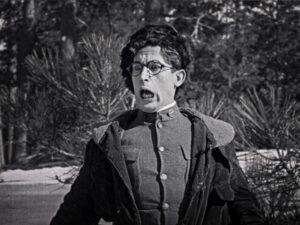Table of Contents
Silent comedies thrive on chaos—the faster, the funnier. And in A Sammy in Siberia, Harold Lloyd finds himself in one of the most chaotic settings imaginable: post-revolutionary Russia. Released in 1919, this short film blends slapstick comedy with action-adventure, dropping Lloyd’s everyman hero into the frozen wilderness of Siberia, where he faces off against Bolshevik bandits in a whirlwind of gags, stunts, and narrow escapes.
While Lloyd is best remembered for his bespectacled “Glasses Character” in later classics like Safety Last! (1923), A Sammy in Siberia captures him in an earlier, wilder phase—before he fully refined his signature persona. Here, he plays an American soldier navigating the absurd dangers of a lawless Siberian town, armed with little more than his wits and impeccable comic timing.

As we dive into this week’s silent gem, let’s explore how A Sammy in Siberia stacks up against Lloyd’s better-known works, what makes its mix of comedy and action unique, and why this short film remains a fascinating glimpse into the adventurous spirit of early cinema.
Plot Summary
The film opens in the snowy wilderness of Siberia, where an American soldier—played by Harold Lloyd—finds himself stationed in a rough, lawless town. Amidst the backdrop of post-revolutionary Russia, the town is plagued by Bolshevik bandits, who terrorize the locals with their unpredictable and often comically exaggerated menace.
Lloyd’s character, a classic underdog, quickly becomes entangled in the chaos when he crosses paths with a young woman (played by Bebe Daniels). She runs a small trading post with her father, struggling to fend off the ruthless gang that has taken over the town. In true Harold Lloyd fashion, what begins as a simple act of heroism soon snowballs into a series of escalating misadventures—filled with clever disguises, daring escapes, and perfectly timed slapstick gags. As the Bolsheviks close in, Lloyd is forced to rely on his quick thinking and physical agility to outmaneuver the villains. Whether he’s using everyday objects as improvised weapons or stumbling his way into unlikely victories, the film keeps the action fast-paced and unpredictable. The climax delivers a thrilling yet humorous showdown, proving once again that Lloyd’s characters may not be the strongest or the toughest—but they always find a way to come out on top.
Harold Lloyd’s Performance
At this point in his career, Harold Lloyd was still refining his signature “Glasses Character,” but A Sammy in Siberia showcases many of the traits that would define his later success—resourcefulness, physical dexterity, and an underdog charm that makes him instantly likable. Unlike the more polished, confident figures he would embody in films like Safety Last! (1923), his character here is a bit rougher around the edges, reacting to danger with wide-eyed surprise rather than calculated daring.
Lloyd’s performance is a delightful mix of slapstick and situational comedy. His interactions with the Bolshevik villains—whether dodging their attacks, outwitting them with split-second ingenuity, or simply surviving by sheer luck—highlight his mastery of physical humor. One particularly memorable moment involves Lloyd using a frozen landscape to his advantage, slipping and sliding just out of reach of his pursuers in a perfectly choreographed comedic ballet.
What makes Lloyd’s performance stand out is his ability to make even the smallest moments feel relatable. Unlike the superhuman acrobatics of Buster Keaton or the sentimental charm of Charlie Chaplin, Lloyd’s humor comes from the idea that he is just an average guy caught in extraordinary circumstances. He doesn’t win fights through strength—he wins by thinking fast, adapting on the fly, and never giving up. Even in a setting as extreme as Siberia, Lloyd’s character remains the everyman hero audiences can root for.
Comedy vs. Action – A Unique Blend
A Sammy in Siberia stands out as a fascinating mix of slapstick comedy and action-adventure, a blend that wasn’t as common in Harold Lloyd’s later, more urban-focused films. Here, the setting—a lawless Siberian outpost—provides a perfect playground for chaos, allowing Lloyd to incorporate elements of both suspense and humor. The film balances high-stakes peril with well-timed gags, creating a unique energy that keeps the audience engaged from start to finish.
The humor in A Sammy in Siberia leans heavily on Lloyd’s knack for physical comedy. His interactions with the Bolshevik bandits—bumbling into trouble, accidentally outmaneuvering them, and using his environment to gain the upper hand—are classic examples of silent film comedy at its best. However, unlike the meticulously choreographed, reality-defying stunts of Buster Keaton, Lloyd’s comedy feels grounded in a way that makes his character more relatable. The danger feels real, but it’s his wit and quick thinking that keep him ahead of his foes.
This film also demonstrates how silent comedies of the era weren’t afraid to experiment with genre. While Lloyd is known for his city-based comedies and daredevil antics, A Sammy in Siberia places him in a more rugged, unpredictable setting, reminiscent of the action-packed serials that were popular at the time. This shift in tone adds an adventurous quality to the film, making it a unique entry in Lloyd’s early work.
Ultimately, the fusion of action and comedy makes A Sammy in Siberia a thrilling watch—not just as a comedy but as a showcase of how silent film could take audiences on wild, unexpected journeys while still delivering plenty of laughs.
https://www.youtube.com/watch?v=Mz8MJ_L9uaI
